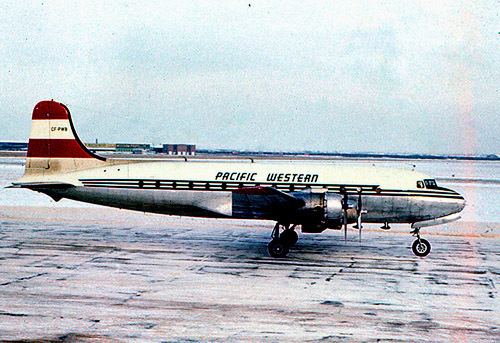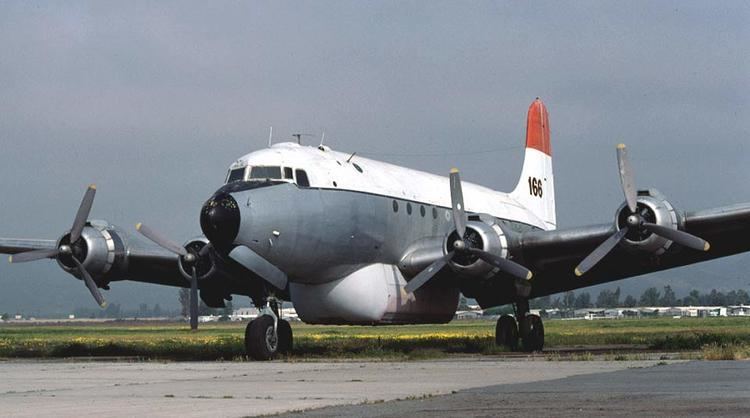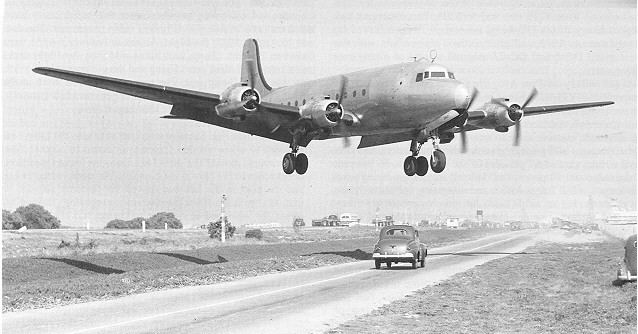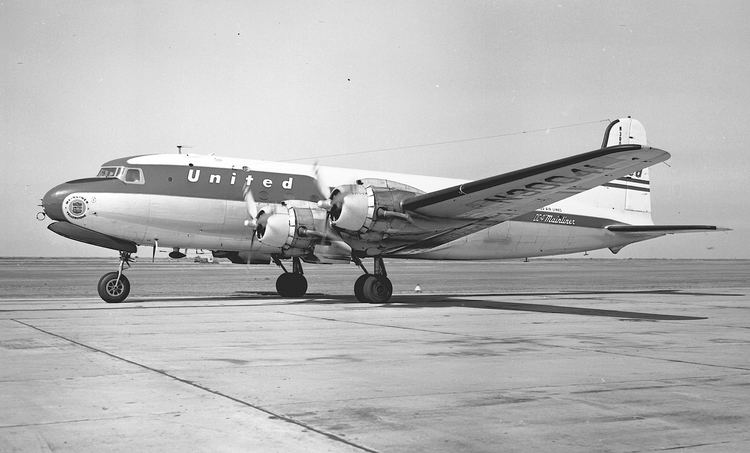Range 6,759 km Length 29 m First flight 1938 | Top speed 451 km/h Wingspan 36 m | |
 | ||
1950 s capital airlines promo film lockheed constellation and douglas dc 4 aircraft
The Douglas DC-4 is a four-engine (piston) propeller-driven airliner developed by the Douglas Aircraft Company. Military versions of the plane, the C-54 and R5D, served during World War II, in the Berlin Airlift and into the 1960s. From 1945, many civil airlines operated the DC-4 worldwide.
Contents
- 1950 s capital airlines promo film lockheed constellation and douglas dc 4 aircraft
- Dda douglas dc 4 skymaster
- Design and development
- Operational history
- Variants
- Survivors
- Specifications DC 4 1009
- References

Dda douglas dc 4 skymaster
Design and development

Following proving flights by United Airlines of the DC-4E it was soon obvious the 52-seat airliner was too large to operate economically and the partner airlines recommended a long list of changes required to the design. Douglas took the new requirement and produced a new design, the DC-4A, with a simpler unpressurised fuselage, R-2000 Twin Wasp engines nd a single fin and rudder.

With the entry of the United States into World War II, in June 1941 the War Department took over the provision orders for the airlines and allocated them to the United States Army Air Forces with the designation C-54 Skymaster. The first, a C-54, flew from Clover Field in Santa Monica, California on 14 February 1942.

To meet military requirements the first production aircraft had four additional auxiliary fuel tanks in the main cabin which reduced the passenger seats to 26. The following batch of aircraft were designated C-54A and were built with a stronger floor, cargo door with a hoist and winch. The first C-54A was delivered in February 1943. With the introduction of the C-54B in March 1944 the outer wings were changed to hold integral fuel tanks allowing two of the cabin tanks to be removed, this allowed 49-seats (or 16 stretchers) to be fitted. The C-54C was a hybrid for Presidential use, it had a C-54A fuselage with four cabin fuel tanks and the C-54B wings with built in tanks to achieve maximum range.

The most common variant was the C-54D which entered service in August 1944, it was a C-54B with more powerfull R-2000-11 engines. With the C-54E the last two cabin fuel tanks were moved to the wings which would allow more freight or 44 passenger seats.
A total of 1,163 C-54/R5Ds were built for the United States military between 1942 and January 1946; another 79 DC-4s were built postwar. A variant, equipped to fly over 40% faster, was built in Canada postwar as the Canadair North Star.
Operational history
The DC-4/C-54 proved a popular and reliable type, 1245 being built between May 1942 and August 1947, including 79 postwar DC-4s. Several remain in service as of 2014. One current operator is Buffalo Airways of Yellowknife, Northwest Territories.
Douglas continued to develop the type during the war in preparation for a return to airline use when peace returned. The type's sales prospects were affected when 500 wartime ex military C-54s and R5Ds came onto the civil market, many being converted to DC-4 standard by Douglas. DC-4s were a favorite of charter airlines such as Great Lakes Airlines, North American Airlines, Universal Airlines and Transocean Airlines. In the 1950s Transocean (Oakland, California) was the largest civil C-54/DC-4 operator.
Douglas produced 79 new-build DC-4s between January 1946 and August 9, 1947, the last example being delivered to South African Airways. Pressurization was an option, but all civil DC-4s (and C-54s) were built un-pressurized.
Purchasers of new-build DC-4s included Pan American Airways, National Airlines, Northwest Airlines and Western Airlines in the USA, and KLM Royal Dutch Air Lines, Scandinavian Airlines System, Iberia Airlines of Spain, Swissair, Air France, Sabena Belgian World Airlines, Cubana de Aviación, Avianca, Aerolíneas Argentinas, Aeropostal of Venezuela (1946) and South African Airways overseas. Several airlines used new-build DC-4s to start scheduled transatlantic flights between Latin America and Europe. Among the earliest were Aerolíneas Argentinas (1946), Aeropostal of Venezuela (1946), Iberia Airlines of Spain (1946), and Cubana de Aviación (1948).
Basic prices for a new DC-4 in 1946-7 was around £140,000-£160,000. In 1960 used DC-4s were available for around £80,000.
Variants
Survivors
Very few DC-4s remain in service today. The last two passenger DC-4s operating worldwide are based in Johannesburg, South Africa. They fly with old South African Airways (SAA) colors. They are ZS-AUB "Outeniqua" and ZS-BMH "Lebombo" and are owned by the South African Airways Museum Society and operated by Skyclass Aviation, a company specializing in classic and VIP charters to exotic destinations in Africa. A 1944 built DC-4 is currently being restored in New South Wales, Australia. Buffalo Airways in Canada's Northwest Territories owns roughly a dozen DC-4s (former C-54s of various versions) 4 for hauling cargo and 3 for aerial firefighting. A 1945 built DC-4 (C-54E) c/n 27370 is currently operating as a flying museum to the Berlin Airlift. Called the "Spirit of Freedom", it has been touring the world for nearly 20 years. Alaska Air Fuel also operates two DC4s out of Palmer, Alaska. One ex-Buffalo DC4 (N55CW c/n 10673, currently registered to AIRCRAFT GUARANTY CORP TRUSTEE) is fitted with spray bars on top of the wings and is currently based in Florida on standby for oil pollution control.
Specifications (DC-4-1009)
General characteristics
Performance
